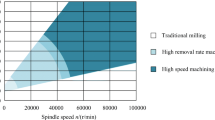Abstract
As a novel class of versatile advanced materials with excellent mechanical, physical, and chemical properties, bulk metallic glasses (BMGs) are promising materials for micro-molds and micro-components. In this paper, the influence of feed rate, rotation speed, and axial depth of cut on surface roughness and top burr size of Zr41.2Ti13.8Cu12.5Ni10Be22.5 bulk metallic glass in a shear dominant zone was investigated by micro-milling with coated two-tooth cemented carbide tools. Initially, the shear dominant zone was identified by analyzing milling force, specific cutting force, surface roughness, and top burr width under different feed rates. Then, a surface morphology model considering the effect of runout was established to study the surface formation process and the influence of runout on surface roughness. Finally, the effects of rotation speed and axial depth of cut on surface roughness and burr size were investigated by an experimental approach. This study proved that, under the optimized parameters, excellent surface quality (Ra around 0.1 μm) and small burr width (below 20 μm) could be obtained by micro-milling Zr-based bulk metallic glass.

























Similar content being viewed by others
References
Zhang L, Huang H (2019) Micro machining of bulk metallic glasses: a review. Int J Adv Manuf Technol 100(1–4):637–661
Zhang N, Srivastava AP, Browne DJ, Gilchrist MD (2016) Performance of nickel and bulk metallic glass as tool inserts for the microinjection molding of polymeric microfluidic devices. J Mater Process Tech 231:288–300
Malekian M, Park SS, Jun MB (2009) Modeling of dynamic micro-milling cutting forces. Int J Mach Tool Manu 49(7–8):586–598
Lai YH, Lee CJ, Cheng YT, Chou HS, Chen HM, Du XH (2008) Bulk and microscale compressive behavior of a Zr-based metallic glass. Scripta Mater 58:890–893
Bakkal M, Nakşler V (2009) Cutting mechanics of bulk metallic glass materials on meso-end milling. Mater Manuf Process 24(12):1249–1255
Han DX, Wang G, Li J, Chan KC, To S, Wu FF, Zhai QJ (2015) Cutting characteristics of Zr-based bulk metallic glass. J Mater Sci Technol 31(2):153–158
Zhao Y, Lu J, Zhang Y, Wu F, Huo D (2016) Development of an analytical model based on a criterion for cutting of metallic glasses. Int J Mech Sci 106:168–175
Chen X, Xiao J, Zhu Y, Tian R, Shu X, Xu J (2017) Micro-machinability of bulk metallic glass in ultra-precision cutting. Mater Design 136:1–12
Park SS, Wei Y, Jin XL (2018) Direct laser assisted machining with a sapphire tool for bulk metallic glass. CIRP Ann 67(1):193–196
Vogler MP, DeVor RE, Kapoor SG (2004) On the modeling and analysis of machining performance in micro-endmilling, part I: surface generation. J Manuf SCI E-T ASME 126(4):685–694
Biermann D, Kahnis P (2010) Analysis and simulation of size effects in micromilling. Product Eng 4(1):25–34
Lekkala R, Bajpai V, Singh RK, Joshi SS (2011) Characterization and modeling of burr formation in micro-end milling. Precis Eng 35(4):625–637
Wu X, Li L, He N (2016) Investigation on the burr formation mechanism in micro cutting. Precis Eng 47:191–196
Pramanik A, Neo KS, Rahman M (2003) Cutting performance of diamond tools during ultra-precision turning of electroless-nickel plated die materials. J Mater Process Tech 140:308–313
Sun Z, To S, Zhang S, Zhang G (2018) Theoretical and experimental investigation into non-uniformity of surface generation in micro-milling. Int J Mech Sci 140:313–324
Wang R, Wang B, Barber GC, Gu J, Schall JD (2019) Models for prediction of surface roughness in a face milling process using triangular inserts. Lubricants 7(1):9
Li C, Lai X, Li H, Ni J (2007) Modeling of three-dimensional cutting forces in micro-end-milling. J Micromech Microeng 17(4):671–678
Chen MJ, Ni HB, Wang ZJ, Jiang Y (2012) Research on the modeling of burr formation process in micro-ball end milling operation on Ti–6Al–4V. Int J Adv Manuf Technol 62(9–12):901–912
Biermann D, Steiner M (2012) Analysis of micro burr formation in austenitic stainless steel X5CrNi18-10. Procedia CIRP 3:97–102
Fujita K, Morishita Y, Nishiyama N, Kimura H, Inoue A (2005) Cutting characteristics of bulk metallic glass. Mater Trans 46(12):2856–2863
Li H, Lai X, Li C, Feng J, Ni J (2007) Modelling and experimental analysis of the effects of tool wear, minimum chip thickness and micro tool geometry on the surface roughness in micro-end-milling. J Micromech Microeng 18(2):025006
Acknowledgements
This work is supported by the China Postdoctoral Science Foundation (Grant Nos. 2019M663043), the National Natural Science Foundation of China (Grant Nos. 51575360 and 51805333), and the Science and Technology Innovation Commission Shenzhen (Grant Nos. JCYJ20170817094310049 and JSGG20170824111725200). The authors are also grateful to the colleagues for their essential contribution to the work.
Author information
Authors and Affiliations
Corresponding author
Additional information
Publisher’s note
Springer Nature remains neutral with regard to jurisdictional claims in published maps and institutional affiliations.
Rights and permissions
About this article
Cite this article
Wang, T., Wu, X., Zhang, G. et al. Study on surface roughness and top burr of micro-milled Zr-based bulk metallic glass in shear dominant zone. Int J Adv Manuf Technol 107, 4287–4299 (2020). https://doi.org/10.1007/s00170-020-05325-7
Received:
Accepted:
Published:
Issue Date:
DOI: https://doi.org/10.1007/s00170-020-05325-7




